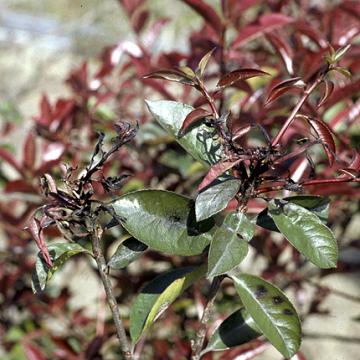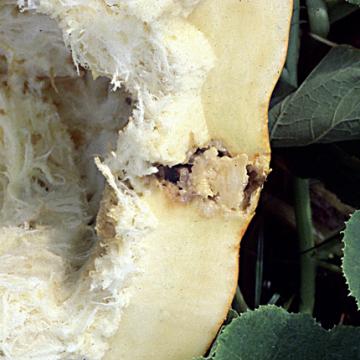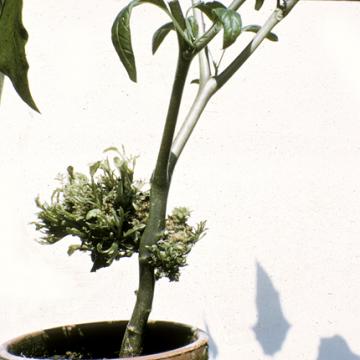DISEASE: Bacterial blight
HOST: Photinia
Symptoms of photinia bud blight shown here are similar to those of blast of pear and apple, caused by Pseudomonas syringae pv. syringae.

Bacterial blight | Photinia
DISEASE: Bacterial blight
HOST: Photinia (Photinia glabra)
PATHOGEN: Pseudomonas syringae pv. photiniae
SOURCE: M. Goto
DISEASE: Bacterial fruit blotch
HOST: Cantaloupe
Early stage of disease with discolored blotches on the surface.

Bacterial fruit blotch | Cantaloupe
DISEASE: Bacterial fruit blotch
HOST: Cantaloupe (Cucumis melo var. cantalupensis)
PATHOGEN: Acidovorax citrulli
PATHOGEN SYNONYM: Acidovorax avenae subsp. citrulli
SOURCE: D. B. Langston
DISEASE: Bacterial fruit blotch
HOST: Cantaloupe
View of disease path from rind to internal rotting of melon.

Bacterial fruit blotch | Cantaloupe
DISEASE: Bacterial fruit blotch
HOST: Cantaloupe (Cucumis melo var. cantalupensis)
PATHOGEN: Acidovorax citrulli
PATHOGEN SYNONYM: Acidovorax avenae subsp. citrulli
SOURCE: R. Gitaitis
DISEASE: Bacterial fruit blotch
HOST: Cantaloupe
Leaf spot stage. Lesions start small and may coalesce, forming large, brown necrotic areas.
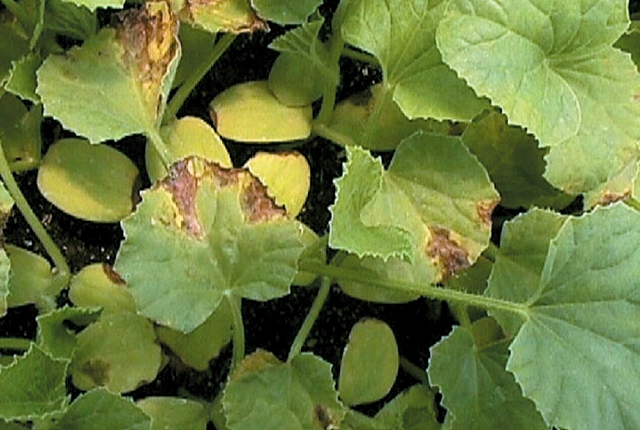
Bacterial fruit blotch | Cantaloupe
DISEASE: Bacterial fruit blotch
HOST: Cantaloupe (Cucumis melo var. cantalupensis)
PATHOGEN: Acidovorax citrulli
PATHOGEN SYNONYM: Acidovorax avenae subsp. citrulli
SOURCE: D. B. Langston
DISEASE: Bacterial wilt
HOST: Cantaloupe
Cantaloupe field with severe destruction from bacterial wilt (left), less on right.

Bacterial wilt | Cantaloupe
DISEASE: Bacterial wilt
HOST: Cantaloupe (Cucumis melo var. cantalupensis)
PATHOGEN: Erwinia tracheiphila
SOURCE: L. Claflin
DISEASE: Crown gall (Leafy gall)
HOST: Datura
Crown gall or leafy gall of datura.
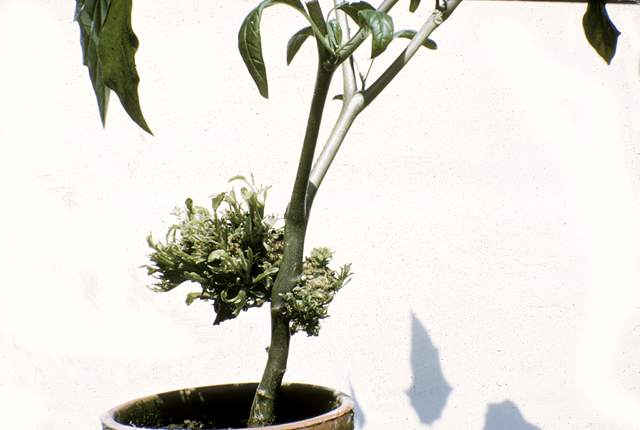
Crown gall (Leafy gall) | Datura
DISEASE: Crown gall (Leafy gall)
HOST: Datura (Datura sp.)
PATHOGEN: Agrobacterium tumefaciens
PATHOGEN SYNONYM: Rhizobium sp.
SOURCE: M. Schroth
DISEASE: Fire blight
HOST: Photinia
Fire blight cankers on photinia.

Fire blight | Photinia
DISEASE: Fire blight
HOST: Photinia (Photinia fraseri)
PATHOGEN: Erwinia amylovora
SOURCE: M. Schroth


